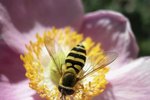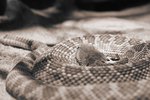
As a group, snakes exhibit a variety of reproductive strategies. Some snakes invest little in each offspring, and deposit several egg clutches per season, while others invest greatly in each individual offspring and only give birth to a litter once every second or third year. Among those that invest heavily in their offspring, the King cobra constructs a nest for their eggs.
King Cobra Natural History
King cobras (Ophiophagus hannah) are the largest venomous snakes in the world, occasionally reaching up to 18 feet. Found throughout Southeast Asia, from India to Indonesia and the Philippines, king cobras reside in forests, savannahs, mangrove swamps and agricultural areas. The color of the adults varies greatly among regions and even within local populations; king cobras may be olive, brown, straw-colored or nearly black. Wild king cobras primarily hunt snakes, including Burmese (Python bivittatus) and reticulated (Python reticulatus) pythons, spectacled (Naja naja) and monocle (Naja kaouthia) cobras, and Asian rat snakes (Ptyas mucosa).
Mating
Male king cobras begin seeking receptive females in January. When a male finds a receptive female, he will wrap his tail around hers, and insert one of his two copulatory organs, termed hemipenes, into her cloaca. Sperm will fertilize the eggs shortly later, though females can store sperm for prolonged periods. Mating is potentially dangerous for king cobras; scientists and zoo keepers have documented that cannibalism occurs from time to time. Mating continues until April, and king cobras may mate with the same individuals during successive years.
Egg Deposition and Incubation
Shortly after mating, female king cobras construct nests from vegetation, sticks and other debris. After finishing construction, she will deposit 20 to 40 eggs inside the nest. Females guard their nests vigilantly and males may stay close to the site as well. When guarding their nest, the usually shy king cobras become very aggressive; most bites to people occur during nest guarding. King cobras are the only snake that scientists have documented to construct nests, and one of the relatively few that guard their eggs at all. It is possible, though not confirmed, that the heat produced by the decaying vegetation of the nest helps to incubate the snake eggs.
Hatching
King cobras hatch from their eggs during the monsoons of the late summer or early fall. Scientists do not know many of the details surrounding the lives of these young snakes. Young king cobras consume snakes and lizards like the adults do, though they may prefer to hunt in the trees. The color pattern of young king cobras differs slightly from that of their parents, being glossy black with yellow or white bands.
Maturation
Wild king cobras likely mature in five to six years, though it can take longer for snakes living in areas with insufficient food. Keepers often provide captive king cobra hatchlings with large quantities of food, and they can attain 6 feet in length by the end of their first year. Mature king cobras measure 9 to 16 feet in length; females often are longer than males. King cobras are long-lived animals and several zoo captives have exceeded 20 years of age.
References
- Animal Diversity Web: Ophiophagus Hannah
- Philadelphia Zoo: King Cobra
- The Animal Information Center: King Cobra
- VenomousAnimals.org: Ophiophagus hannah -- Captive Care Notes
- Gowrishankar's Blog: A Kings Platter
- Nature in Singapore: The King Cobra (Ophiophagus hannah) in Singapore
- Ophiophagus.nl: Raising Baby King Cobras
- Academia.edu: Intra-Indivdual Variation in Clutch and Offspring Size in an Oviparous Snake
- Penn State University: Crotalus horridus
Resources
Photo Credits
-
Jupiterimages/Photos.com/Getty Images



